Abstract
Some animal studies and some human studies suggest that exposure to 2,3,7,8-tetrachlorodibenzo-p-dioxin (TCDD) may be associated with adverse effects on the cardiovascular system. As part of a cross-sectional medical study comparing workers employed 15 years earlier in the manufacture of 2,4,5-trichlorophenol or one of its derivatives at two U.S. chemical plants with an unexposed comparison group, we examined the association between TCDD exposure and various cardiovascular outcomes. A total of 281 workers and 260 unexposed referents participated. The workers had substantial exposure to TCDD, as demonstrated by significantly elevated mean serum TCDD concentration of 220 pg/g of lipid, compared with 7 pg/g of lipid among the referents. No significant association was found between TCDD exposure and any of the cardiovascular outcomes including myocardial infarction, angina, cardiac arrhythmias, hypertension, and abnormal peripheral arterial flow. Although our study had sufficient statistical power to detect an elevated risk for cardiac arrhythmias, hypertension, and abnormal peripheral arterial flow, it had low power (approximately 50%) to detect an elevated risk for myocardial infarction and angina. Our review of the literature suggests that our negative findings are consistent with those from other cross-sectional medical studies. Although several mortality studies of TCDD-exposed cohorts found significantly increased risks for cardiovascular disease mortality, similar increased risks were not observed in other mortality studies. The data available do not provide definitive conclusions but indicate that further examination of the association between TCDD exposure and cardiovascular disease should be pursued.
Full text
PDF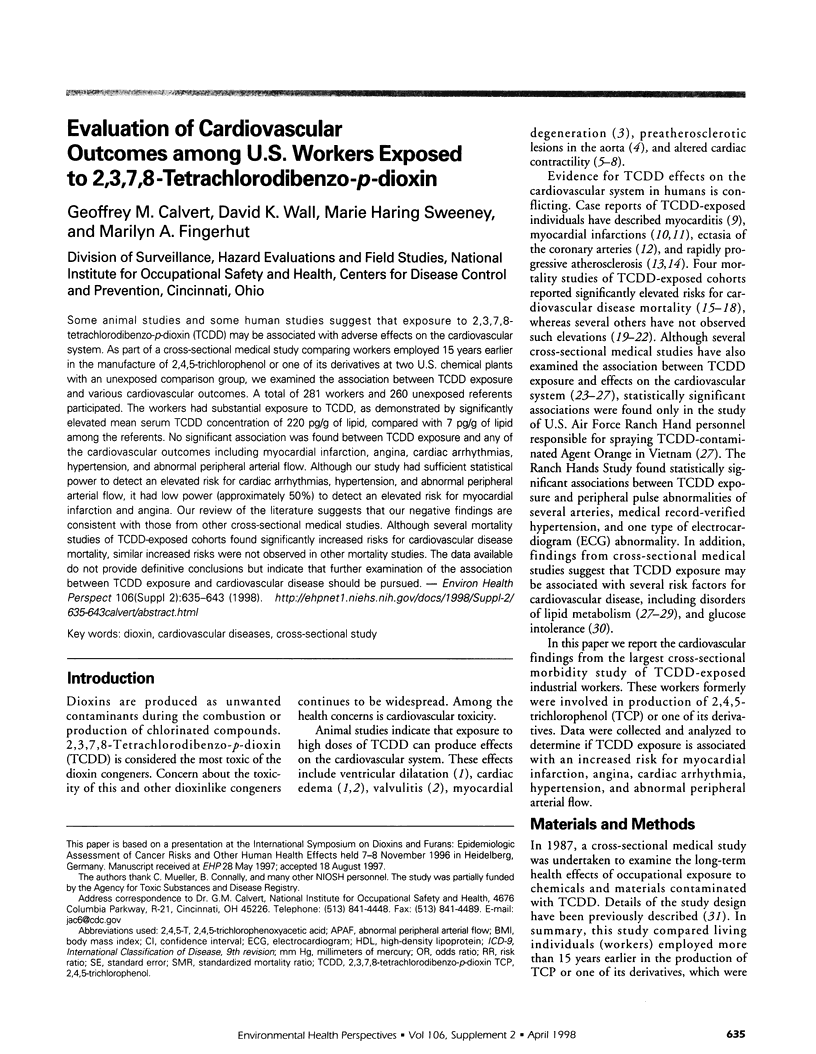
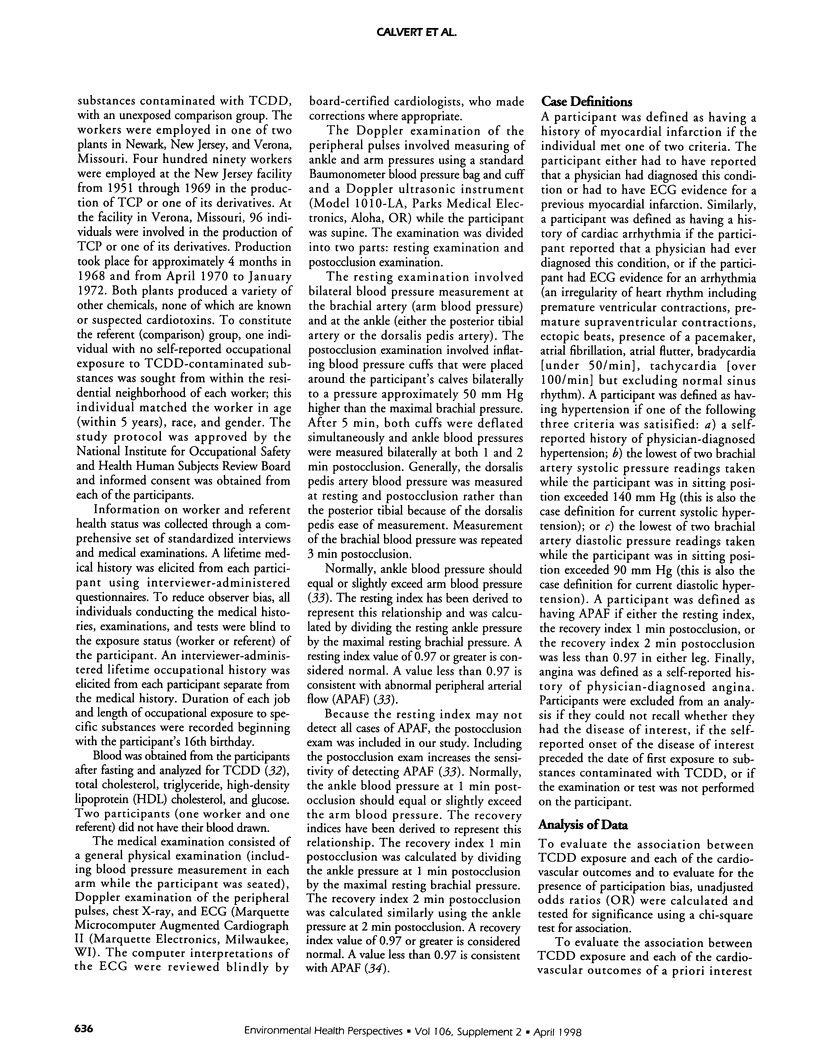
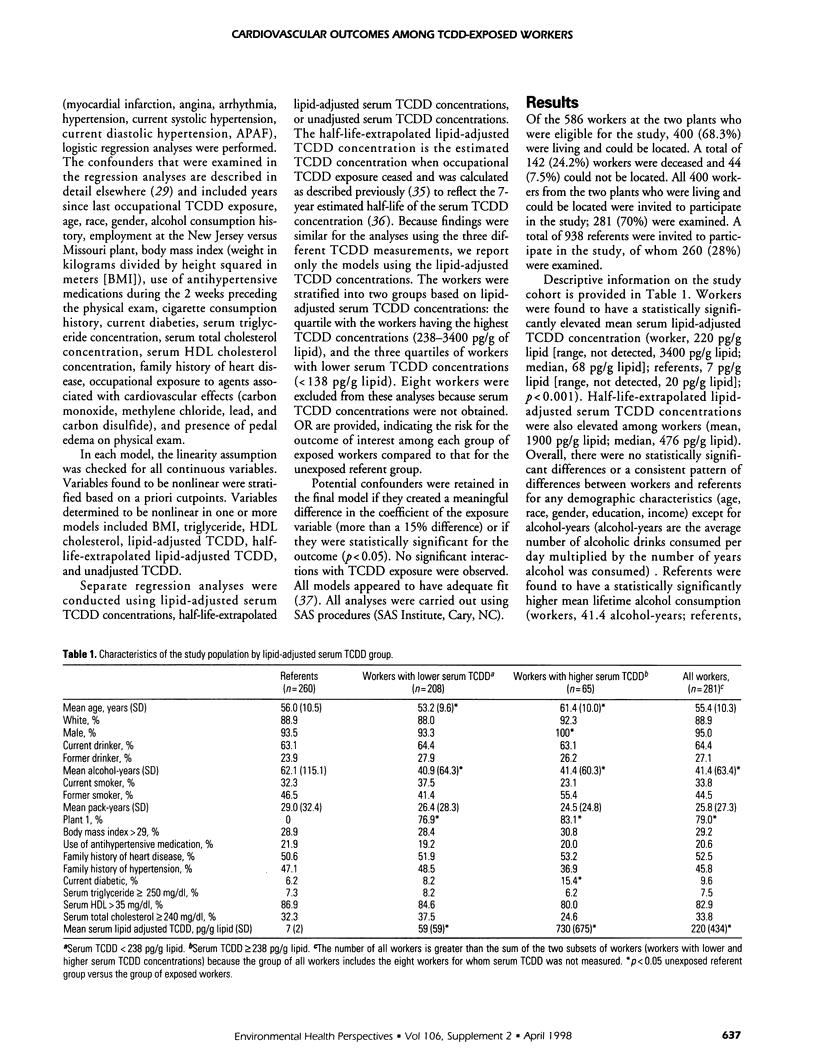
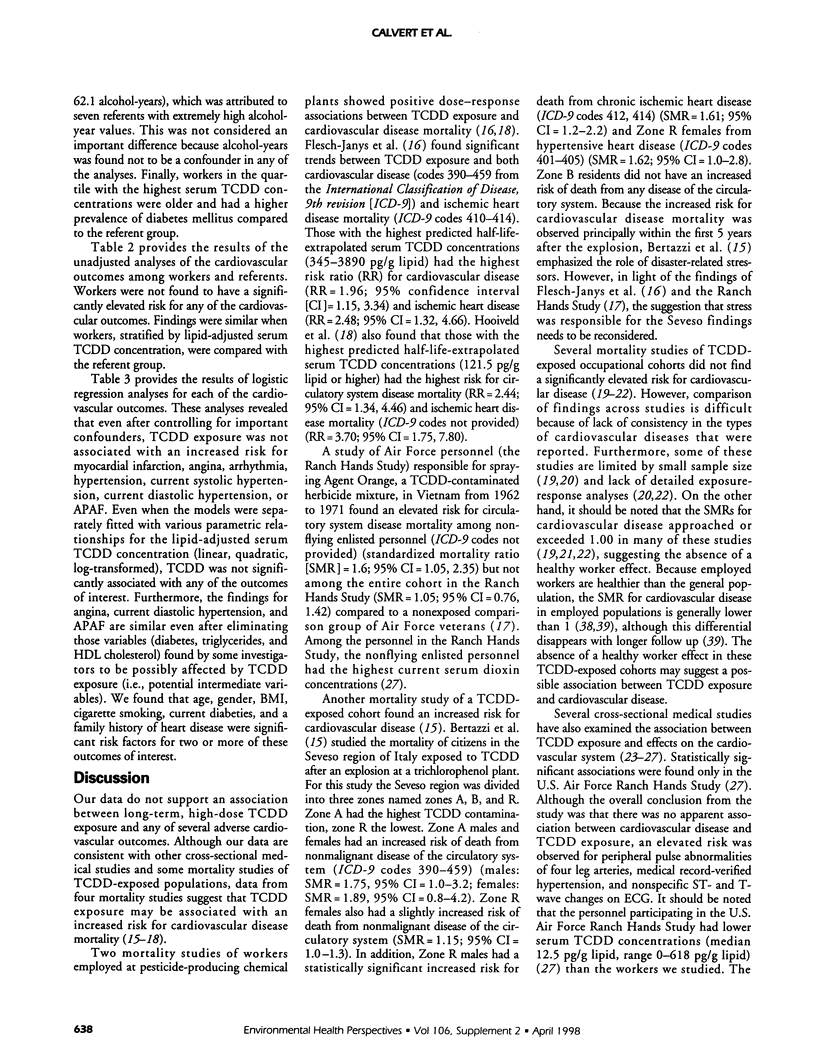
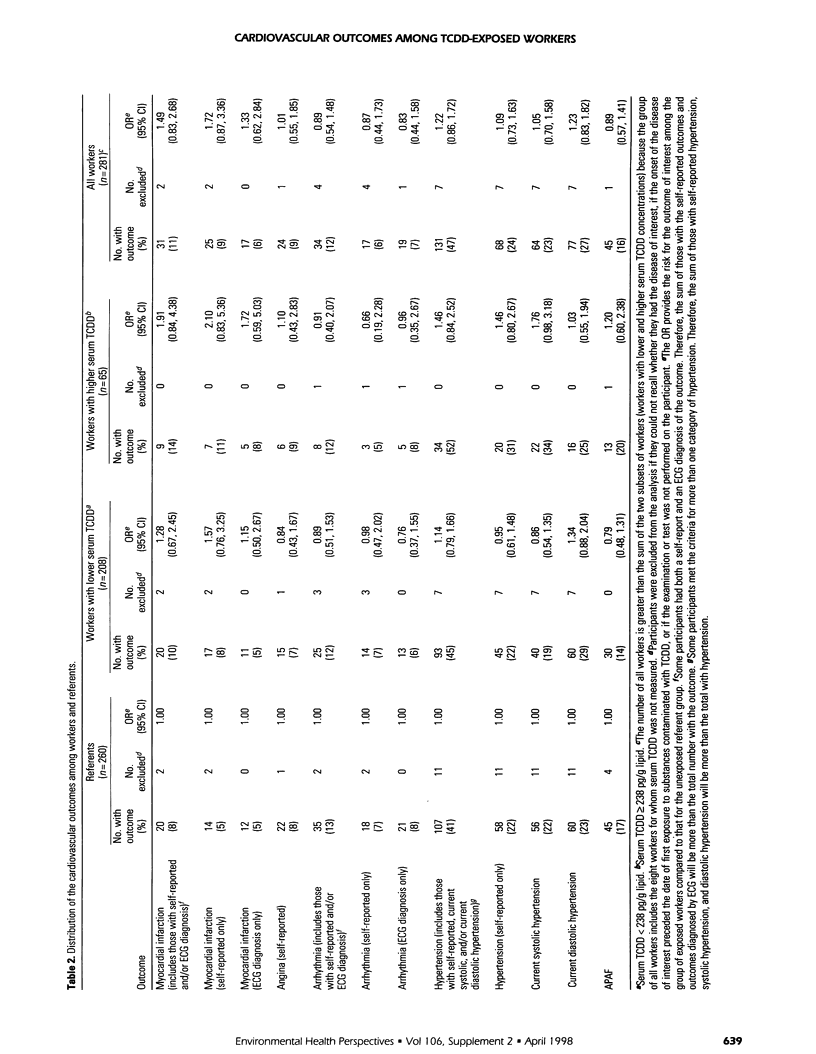
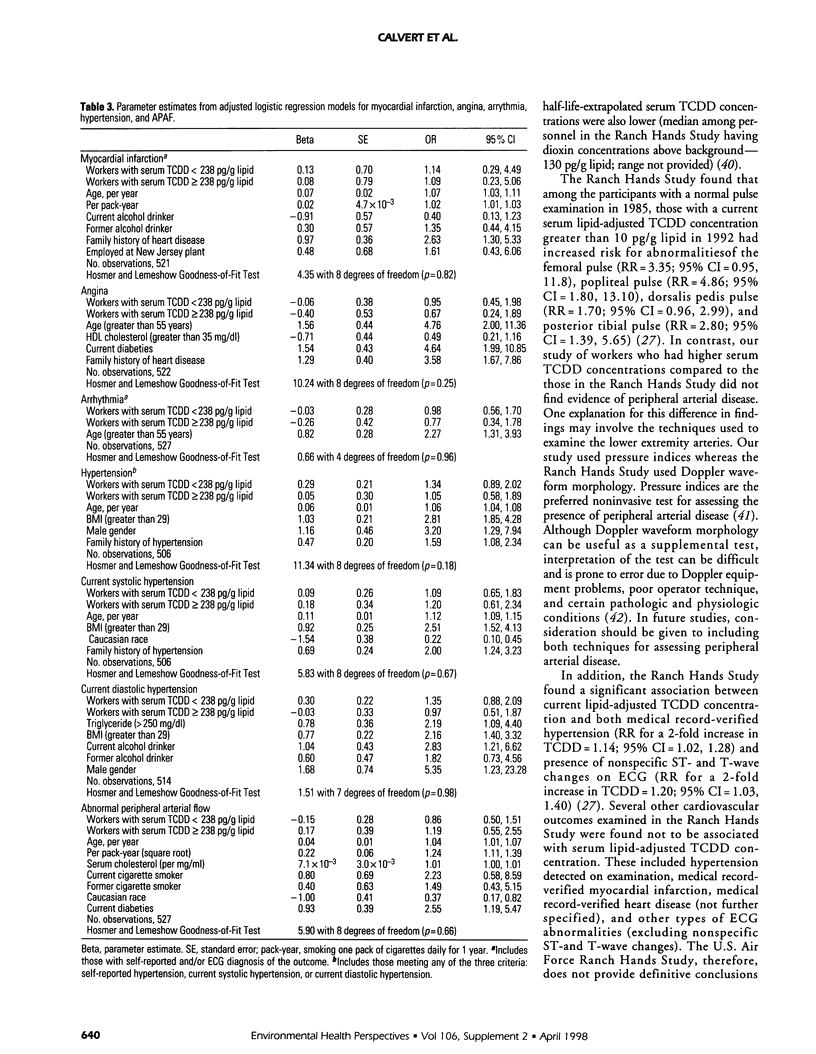
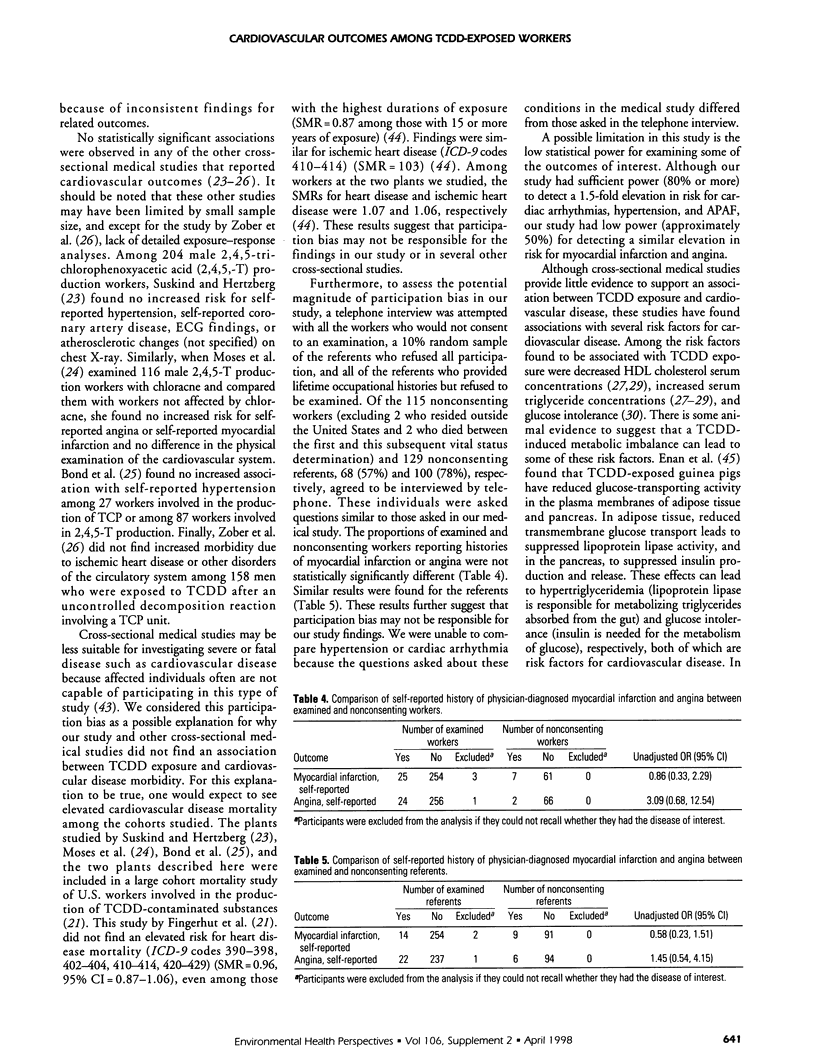

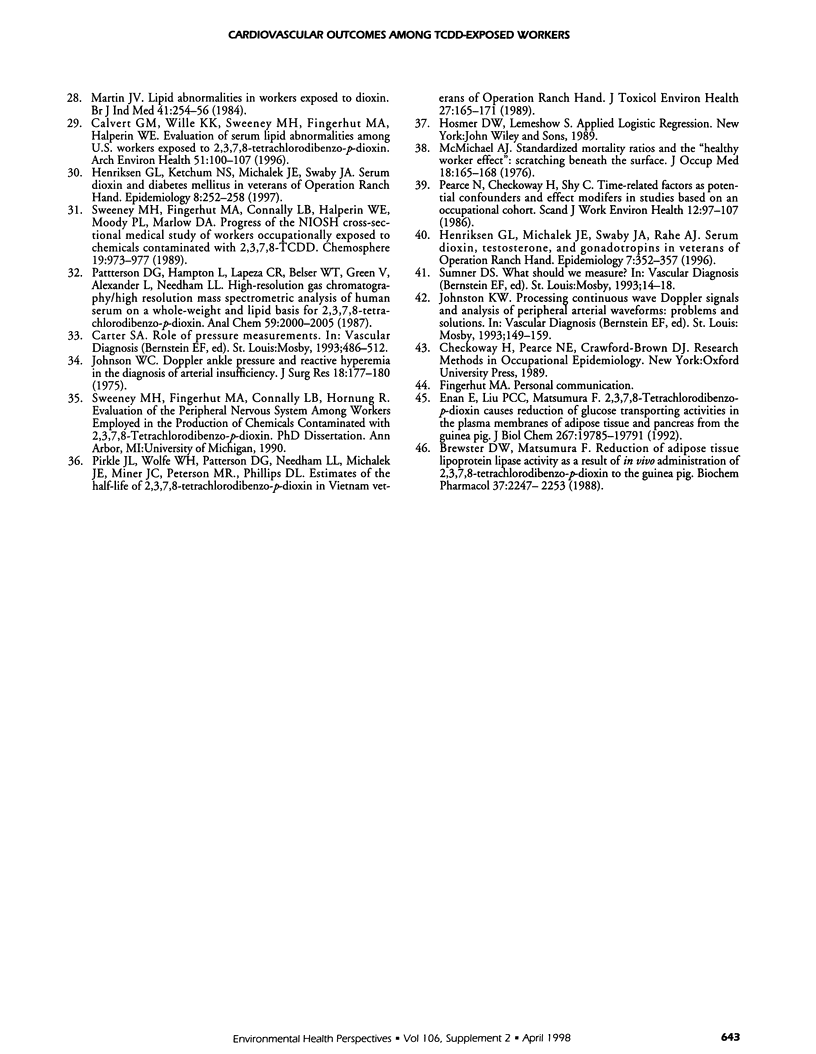
Selected References
These references are in PubMed. This may not be the complete list of references from this article.
- Allen J. R., Barsotti D. A., Van Miller J. P., Abrahamson L. J., Lalich J. J. Morphological changes in monkeys consuming a diet containing low levels of 2,3,7,8-tetrachlorodibenzo-p-dioxin. Food Cosmet Toxicol. 1977 Oct;15(5):401–410. doi: 10.1016/s0015-6264(77)80004-7. [DOI] [PubMed] [Google Scholar]
- BAUER H., SCHULZ K. H., SPIEGELBERG U. [Occupational poisonings in the production of chlorphenol compounds]. Arch Gewerbepathol Gewerbehyg. 1961;18:538–555. [PubMed] [Google Scholar]
- Bertazzi P. A., Zocchetti C., Pesatori A. C., Guercilena S., Sanarico M., Radice L. Ten-year mortality study of the population involved in the Seveso incident in 1976. Am J Epidemiol. 1989 Jun;129(6):1187–1200. doi: 10.1093/oxfordjournals.aje.a115240. [DOI] [PubMed] [Google Scholar]
- Bond G. G., Ott M. G., Brenner F. E., Cook R. R. Medical and morbidity surveillance findings among employees potentially exposed to TCDD. Br J Ind Med. 1983 Aug;40(3):318–324. doi: 10.1136/oem.40.3.318. [DOI] [PMC free article] [PubMed] [Google Scholar]
- Brewster D. W., Bombick D. W., Matsumura F. Rabbit serum hypertriglyceridemia after administration of 2,3,7,8-tetrachlorodibenzo-p-dioxin (TCDD). J Toxicol Environ Health. 1988;25(4):495–507. doi: 10.1080/15287398809531227. [DOI] [PubMed] [Google Scholar]
- Brewster D. W., Matsumura F., Akera T. Effects of 2,3,7,8-tetrachlorodibenzo-p-dioxin on guinea pig heart muscle. Toxicol Appl Pharmacol. 1987 Jul;89(3):408–417. doi: 10.1016/0041-008x(87)90160-8. [DOI] [PubMed] [Google Scholar]
- Brewster D. W., Matsumura F. Reduction of adipose tissue lipoprotein lipase activity as a result of in vivo administration of 2,3,7,8-tetrachlorodibenzo-p-dioxin to the guinea pig. Biochem Pharmacol. 1988 Jun 1;37(11):2247–2253. doi: 10.1016/0006-2952(88)90588-6. [DOI] [PubMed] [Google Scholar]
- Buu-Hoï N. P., Chanh P. H., Sesque G., Azum-Gelade M. C., Saint-Ruf G. Organs as targets of "dioxin" (2,3,7,8-tetrachlorodibenzo-p-dioxin) intoxication. Naturwissenschaften. 1972 Apr;59(4):174–175. doi: 10.1007/BF00637374. [DOI] [PubMed] [Google Scholar]
- Calvert G. M., Willie K. K., Sweeney M. H., Fingerhut M. A., Halperin W. E. Evaluation of serum lipid concentrations among U.S. workers exposed to 2,3,7,8-tetrachlorodibenzo-p-dioxin. Arch Environ Health. 1996 Mar-Apr;51(2):100–107. doi: 10.1080/00039896.1996.9936001. [DOI] [PubMed] [Google Scholar]
- Canga L., Levi R., Rifkind A. B. Heart as a target organ in 2,3,7,8-tetrachlorodibenzo-p-dioxin toxicity: decreased beta-adrenergic responsiveness and evidence of increased intracellular calcium. Proc Natl Acad Sci U S A. 1988 Feb;85(3):905–909. doi: 10.1073/pnas.85.3.905. [DOI] [PMC free article] [PubMed] [Google Scholar]
- Coggon D., Pannett B., Winter P. Mortality and incidence of cancer at four factories making phenoxy herbicides. Br J Ind Med. 1991 Mar;48(3):173–178. doi: 10.1136/oem.48.3.173. [DOI] [PMC free article] [PubMed] [Google Scholar]
- Enan E., Liu P. C., Matsumura F. 2,3,7,8-Tetrachlorodibenzo-p-dioxin causes reduction of glucose transporting activities in the plasma membranes of adipose tissue and pancreas from the guinea pig. J Biol Chem. 1992 Oct 5;267(28):19785–19791. [PubMed] [Google Scholar]
- England J. F. Herbicides and coronary ectasia. Med J Aust. 1981 Feb 7;1(3):140–140. doi: 10.5694/j.1326-5377.1981.tb135392.x. [DOI] [PubMed] [Google Scholar]
- Flesch-Janys D., Berger J., Gurn P., Manz A., Nagel S., Waltsgott H., Dwyer J. H. Exposure to polychlorinated dioxins and furans (PCDD/F) and mortality in a cohort of workers from a herbicide-producing plant in Hamburg, Federal Republic of Germany. Am J Epidemiol. 1995 Dec 1;142(11):1165–1175. doi: 10.1093/oxfordjournals.aje.a117575. [DOI] [PubMed] [Google Scholar]
- Goldmann P. J. Schwerste akute Chloracne, eine Massenintoxikation durch 2,3,6,7-Tetrachlordibenzodioxin. Hautarzt. 1973 Apr;24(4):149–152. [PubMed] [Google Scholar]
- Henriksen G. L., Ketchum N. S., Michalek J. E., Swaby J. A. Serum dioxin and diabetes mellitus in veterans of Operation Ranch Hand. Epidemiology. 1997 May;8(3):252–258. doi: 10.1097/00001648-199705000-00005. [DOI] [PubMed] [Google Scholar]
- Henriksen G. L., Michalek J. E., Swaby J. A., Rahe A. J. Serum dioxin, testosterone, and gonadotropins in veterans of Operation Ranch Hand. Epidemiology. 1996 Jul;7(4):352–357. [PubMed] [Google Scholar]
- Hermansky S. J., Holcslaw T. L., Murray W. J., Markin R. S., Stohs S. J. Biochemical and functional effects of 2,3,7,8-tetrachlorodibenzo-p-dioxin (TCDD) on the heart of female rats. Toxicol Appl Pharmacol. 1988 Sep 15;95(2):175–184. doi: 10.1016/0041-008x(88)90154-8. [DOI] [PubMed] [Google Scholar]
- Jirásek L., Kalenský J., Kubec K., Pazderová J., Lukás E. Acne chlorina, porphyria cutanea tarda a jiné projevy celkové intoxikace pri výrobe herbidic. II. Cesk Dermatol. 1974 Jun;49(3):145–157. [PubMed] [Google Scholar]
- Johnson W. C. Doppler ankle pressure and reactive hyperemia in the diagnosis of arterial insufficiency. J Surg Res. 1975 Feb;18(2):177–180. doi: 10.1016/0022-4804(75)90013-x. [DOI] [PubMed] [Google Scholar]
- Kelling C. K., Menahan L. A., Peterson R. E. Effects of 2,3,7,8-tetrachlorodibenzo-p-dioxin treatment on mechanical function of the rat heart. Toxicol Appl Pharmacol. 1987 Dec;91(3):497–501. doi: 10.1016/0041-008x(87)90072-x. [DOI] [PubMed] [Google Scholar]
- Kociba R. J., Keyes D. G., Beyer J. E., Carreon R. M., Wade C. E., Dittenber D. A., Kalnins R. P., Frauson L. E., Park C. N., Barnard S. D. Results of a two-year chronic toxicity and oncogenicity study of 2,3,7,8-tetrachlorodibenzo-p-dioxin in rats. Toxicol Appl Pharmacol. 1978 Nov;46(2):279–303. doi: 10.1016/0041-008x(78)90075-3. [DOI] [PubMed] [Google Scholar]
- Martin J. V. Lipid abnormalities in workers exposed to dioxin. Br J Ind Med. 1984 May;41(2):254–256. doi: 10.1136/oem.41.2.254. [DOI] [PMC free article] [PubMed] [Google Scholar]
- McMichael A. J. Standardized mortality ratios and the "healthy worker effect": Scratching beneath the surface. J Occup Med. 1976 Mar;18(3):165–168. doi: 10.1097/00043764-197603000-00009. [DOI] [PubMed] [Google Scholar]
- Moses M., Lilis R., Crow K. D., Thornton J., Fischbein A., Anderson H. A., Selikoff I. J. Health status of workers with past exposure to 2,3,7,8-tetrachlorodibenzo-p-dioxin in the manufacture of 2,4,5-trichlorophenoxyacetic acid: comparison of findings with and without chloracne. Am J Ind Med. 1984;5(3):161–182. doi: 10.1002/ajim.4700050303. [DOI] [PubMed] [Google Scholar]
- Patterson D. G., Jr, Hampton L., Lapeza C. R., Jr, Belser W. T., Green V., Alexander L., Needham L. L. High-resolution gas chromatographic/high-resolution mass spectrometric analysis of human serum on a whole-weight and lipid basis for 2,3,7,8-tetrachlorodibenzo-p-dioxin. Anal Chem. 1987 Aug 1;59(15):2000–2005. doi: 10.1021/ac00142a023. [DOI] [PubMed] [Google Scholar]
- Pazderova-Vejlupková J., Lukás E., Nemcova M., Pícková J., Jirásek L. The development and prognosis of chronic intoxication by tetrachlordibenzo-p-dioxin in men. Arch Environ Health. 1981 Jan-Feb;36(1):5–11. doi: 10.1080/00039896.1981.10667598. [DOI] [PubMed] [Google Scholar]
- Pearce N., Checkoway H., Shy C. Time-related factors as potential confounders and effect modifiers in studies based on an occupational cohort. Scand J Work Environ Health. 1986 Apr;12(2):97–107. doi: 10.5271/sjweh.2161. [DOI] [PubMed] [Google Scholar]
- Pirkle J. L., Wolfe W. H., Patterson D. G., Needham L. L., Michalek J. E., Miner J. C., Peterson M. R., Phillips D. L. Estimates of the half-life of 2,3,7,8-tetrachlorodibenzo-p-dioxin in Vietnam Veterans of Operation Ranch Hand. J Toxicol Environ Health. 1989;27(2):165–171. doi: 10.1080/15287398909531288. [DOI] [PubMed] [Google Scholar]
- Suskind R. R., Hertzberg V. S. Human health effects of 2,4,5-T and its toxic contaminants. JAMA. 1984 May 11;251(18):2372–2380. [PubMed] [Google Scholar]
- Walker A. E., Martin J. V. Lipid profiles in dioxin-exposed workers. Lancet. 1979 Feb 24;1(8113):446–447. doi: 10.1016/s0140-6736(79)90929-2. [DOI] [PubMed] [Google Scholar]
- Zack J. A., Suskind R. R. The mortality experience of workers exposed to tetrachlorodibenzodioxin in a trichlorophenol process accident. J Occup Med. 1980 Jan;22(1):11–14. [PubMed] [Google Scholar]
- Zober A., Messerer P., Huber P. Thirty-four-year mortality follow-up of BASF employees exposed to 2,3,7,8-TCDD after the 1953 accident. Int Arch Occup Environ Health. 1990;62(2):139–157. doi: 10.1007/BF00383591. [DOI] [PubMed] [Google Scholar]
- Zober A., Ott M. G., Messerer P. Morbidity follow up study of BASF employees exposed to 2,3,7, 8-tetrachlorodibenzo-p-dioxin (TCDD) after a 1953 chemical reactor incident. Occup Environ Med. 1994 Jul;51(7):479–486. doi: 10.1136/oem.51.7.479. [DOI] [PMC free article] [PubMed] [Google Scholar]


